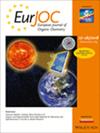Discovery of Some New Heterocyclic Systems from Carbene‐Based Reactions of Indigo and N‐Methyl Derivatives
IF 2.7
3区 化学
Q2 CHEMISTRY, ORGANIC
引用次数: 0
Abstract
Reactions of靛蓝和N -甲基衍生物在碳基反应中发现了一些新的杂环体系
研究了N,N ' -二甲基林二哥与二氯羰基或类羰基铑的反应,从而一锅制得新的、复杂的杂环衍生物。其中一个原因是整个环之间的相互转化过程与环扩展产生了一种新的八元环融合苯并[6,7][1,5]恶唑啉[3,2 - b]吲哚- 13 - 1衍生物。另外,一个完整的环构建过程产生了一个前所未有的螺旋环2H,4H -螺旋[furo[3,2 - b]吲哚- 3,2 ' -吲哚]体系。一些嵌入6H -吡啶[1,2 - A:3,4 - b ']二吲哚核心的产物也被报道,这些产物与丙二烯基铑酯类羰基中间体反应,以及一些其他类羰基衍生物。这些反应明显依赖溶剂。用N -甲基靛蓝或母体靛蓝作为底物的反应路径也有差异,并提出了可能的机制。
本文章由计算机程序翻译,如有差异,请以英文原文为准。
求助全文
约1分钟内获得全文
求助全文
来源期刊
CiteScore
5.40
自引率
3.60%
发文量
752
审稿时长
1 months
期刊介绍:
The European Journal of Organic Chemistry (2019 ISI Impact Factor 2.889) publishes Full Papers, Communications, and Minireviews from the entire spectrum of synthetic organic, bioorganic and physical-organic chemistry. It is published on behalf of Chemistry Europe, an association of 16 European chemical societies.
The following journals have been merged to form two leading journals, the European Journal of Organic Chemistry and the European Journal of Inorganic Chemistry:
Liebigs Annalen
Bulletin des Sociétés Chimiques Belges
Bulletin de la Société Chimique de France
Gazzetta Chimica Italiana
Recueil des Travaux Chimiques des Pays-Bas
Anales de Química
Chimika Chronika
Revista Portuguesa de Química
ACH—Models in Chemistry
Polish Journal of Chemistry.

 求助内容:
求助内容: 应助结果提醒方式:
应助结果提醒方式:


